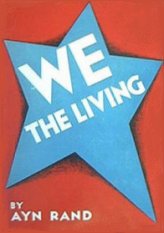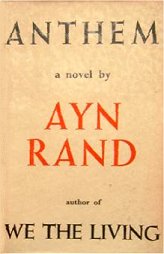

|
[EDITOR'S NOTE: This is an abridged version of the complete article. Click here; to purchase.] BOOKSELLER'S AUTHOR REPORT: AYN RAND FULL NAME: Alisa Zinov'yevna Rosenbaum PSEUDONYMS: Ayn Rand BIRTH/DEATH: February 2, 1905 - March 6, 1982 WEBSITE: None 
BIOGRAPHICAL AND PUBLISHING NOTES: If you've knocked about academia much, you've seen it happen. Probably often. For the precocious it could pop up as early Freshman year in college, but for the average bear it's more likely a Sophomore thing - you know, after those first two I'm-scared-let's-just-survive semesters are in the can and something approximating breathing room allows one, for the first time, to gaze about and assess one's place in the scheme of things. And then experience what we all seem to come face to face with on the path to adulthood - a vacuum of self-worth. Into this vacuum one or more things can and inevitably do get sucked, but a real cause, something one can sink one's teeth into and at least begin to bang together the framework of an identity, is the most likely culprit. If the cause is Objectivism, the conversion is nothing if not swift - from wide-eyed unknowing to steely-eyed certainty, seemingly overnight. Or as many lamp-lit, deep-into-the-night hours it takes to devour The Fountainhead or Atlas Shrugged. Say what you will about Ayn Rand's prowess as a novelist; it can't be denied that she can convert collegiate masses by the boatload. Still. Actually, in our present times, let's say resurgently, as the Great Recession was handed first to government for a fix and now swings back, if tentatively, to Rand's cause célèbre - laissez faire capitalism. Sales of both Rand books are soaring, by the way. From Slate: "When people started talking about President Obama and the return of reading, they probably didn't mean Ayn Rand. But the Obama presidency has been a boon to Rand's publishers. Buried in George Will's upcoming column is the nugget that sales of Atlas Shrugged have tripled since Obama took office. From 2000 through 2008, the 50-year-old 1,088-page tome sold about 166,000 copies a year. Since Obama was sworn in, more than 600,000 copies have been sold. That's 530,000 more than it sold in its first year of publication, when it was reviewed by more than 100 literary outlets. It's the second-best selling political book on Amazon, ahead of trashy political thrillers and behind only Glenn Beck's forthcoming opus The Overton Window. Rand's place on so many modern must-read lists is due to men like Ron Johnson, a tea partier who is likely to win the Republican nomination for the Wisconsin Senate race. Johnson wishes Atlas Shrugged were longer. He says 'we're living it,' in reference to Rand's 'dystopian world in which society's producers are weighed down by parasitic non-producers.' And he waxes nostalgic about the Reagan era, when even the wealthiest didn't pay more than a 28 percent income tax. 'For a brief moment,' Johnson said, 'we were 72 percent free.'" Perhaps Rand's appeal with young readers has something to do with the celebration of the misunderstood individual, the shameless promotion of self-interest, or some other personal matter of interest to twentysomethings, but I suspect it also has much to do with the crackling fire of reason itself, which promises an answer - sometimes the answer - without being personal at all. Confine one's seeking to reason, and there's no need to expose the self in one's quest, and besides, there's genuine comfort in the precision of concept formation and the logic that follows from it. What distinguishes Rand from so many other practitioners of the novel is her bold use of the vehicle for reasons not typically employed - namely, to inculcate a philosophical system. For some of us this spoils things. For me it brings to mind the protracted, tiresome epilogue in Tolstoy's War and Peace, in which the author, after penning one most remarkable stories ever told, attempts to explain his vision of history and how his story illustrates it. Groan. Rand takes this a step further: Instead of tacking on an epilogue, she informs the stories themselves with her teachings, necessarily reducing her characters to near lifeless, if archetypal puppets. Many critics saw through this early on, and perhaps Rand's decision to abandon fiction for non-fiction later in life was in some measure a response. Most early converts to Objectivism leave it behind soon enough, for whatever reason, though a few carry the torch onward, former Federal Reserve Chairman Alan Greenspan being an especially notable example. But there are things afoot here that drive sales notwithstanding, not the least of which is simple nostalgia for one's college days and an urge to recapture something from them. Given our present economic climate, it's also possible that one might revisit the content that was left behind so long ago for present applicability. More factors include the larger-than-life aura Rand exudes, a phenomenon enhanced by none other than how she led her life - an intense and sustained political activism, even the scandalous affair with the much junior Nathaniel Branden - and of course the controversy ever swirling around Objectivism itself. Rand produced only five works of fiction, three novels (We the Living, The Fountainhead and Atlas Shrugged), a play (Night of January 16th) and a novella (Anthem) but there's a more significant body of non-fiction in the form of books, articles, etc., that grow her bibliography from booklet to book. The standard resource to date is Vincent L. Perinn's Ayn Rand: First Descriptive Bibliography, which covers primary materials only.  A bibliography of secondary materials would be a monumental undertaking, given the level of interest over decades, but to date few of them are of much value to booksellers. Readers have little need, I suppose, for books that explain books that are explanations? Rand signatures are semi-numerous in the marketplace and split more or less cleanly into two types, the first being observable up to and including the publication of The Fountainhead in the early 1940s. Note here the somewhat random orientation of the letters, a triangular loop on the "y" and a closed loop on the "R":  A transition occurred sometime later in the 1940s. A more severely vertical orientation then appeared with a loop-less "y" and an open-looped "R":  No doubt a handwriting analyst could have some fun with this, but there's some consensus that would suggest that the triangular loop is evidence of an appetite for sexual experimentation - rumors of Rand's bisexuality, however, are just rumors - and the loop-less "y" as indicative of loneliness. That Rand championed separatism of the individual dovetails with the latter. In any case, it's quite simple to dismiss a second example appearing on an early publication as contemporary to it, and less savvy collectors will appreciate your effort to explain this. MARKETING ANALYSIS: First and foremost, all Ayn Rand fiction is highly collectible, including first and early printings, and all first printings pre-dating her last novel, Atlas Shrugged, will finish deep into three figures unless condition is very poor indeed. Dust jackets will often push things into four figures. Given that the first print run was a whopping 100,000, outcomes for Atlas Shrugged will lag behind this somewhat but are impressive notwithstanding (lower three figures, typically, though four figures is possible in exceptional condition with a dust jacket). Compare this to 19,500 for The Fountainhead. Signatures add hundreds to outcomes, early examples more so. Remember the loops! Along with first printings of Atlas Shrugged, what's most likely to provide consistent income for booksellers are ... [Subscribe or purchase this Author Report for more information.] BIBLIOGRAPHY: 1. We the Living
 1936. New York. The Macmillan Company. "Published April 1936" stated on title page verso. No additional printings. Dust jacket price: $2.50. 3,000 copies. 2. Anthem  1938. London. Cassell and Company. "First Published 1938" stated on title page verso. No additional printings. Dust jacket price: 6s. Second state dust jacket with "Colonial Edition" printed on flap. 3,500 copies. 3. The Fountainhead 1943. New York. The Bobbs-Merrill Company. "First Edition" stated on title page verso. First issue (7,500 copies) bound in red cloth. Second issue (12,000 copies) bound in green cloth. Dust jacket price: $3.00. First issue dust jacket with sixteen Bobbs-Merrill titles on back panel. Second issue dust jacket with photograph of author and three reviews on back panel. [Subscribe or purchase this Author Report for more information.]
>>>>> Article continues on next page >>>>>
Questions or comments?
| Forum
| Store
| Publications
| BookLinks
| BookSearch
| BookTopics
| Archives
| Advertise
| AboutUs
| ContactUs
| Search Site
| Site Map
| Google Site Map
Store - Specials
| BookHunt
| BookShelf
| Gold Edition & BookThink's Quarterly Market Report
| DomainsForSale
| BookThinker newsletter - free
Copyright 2003-2011 by BookThink LLC
|

|
|